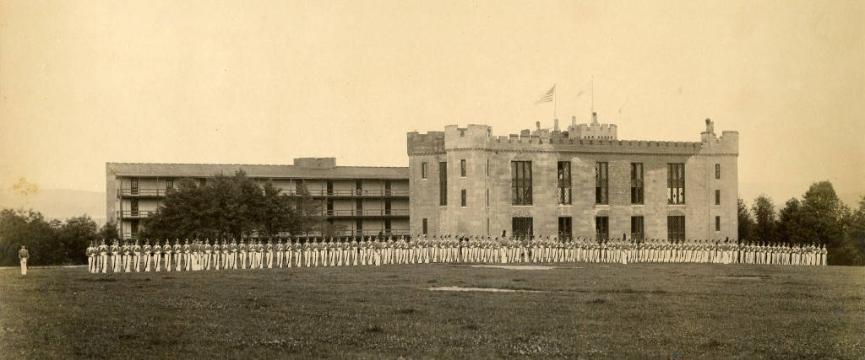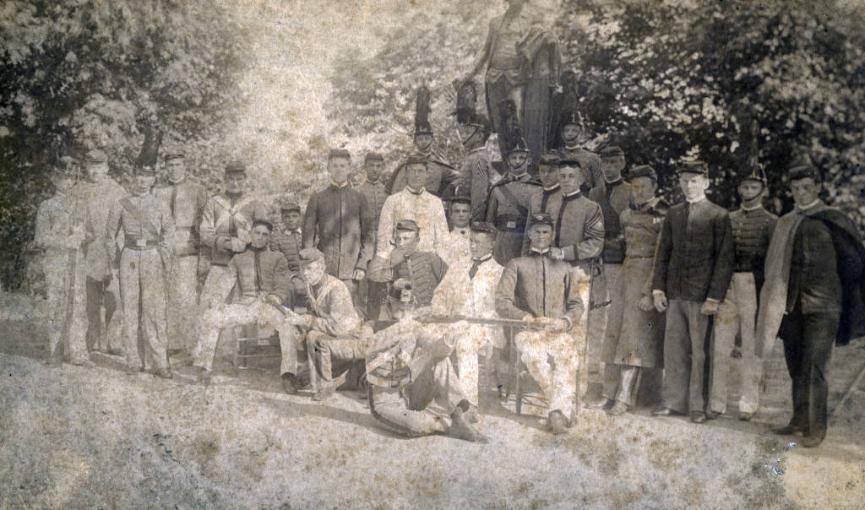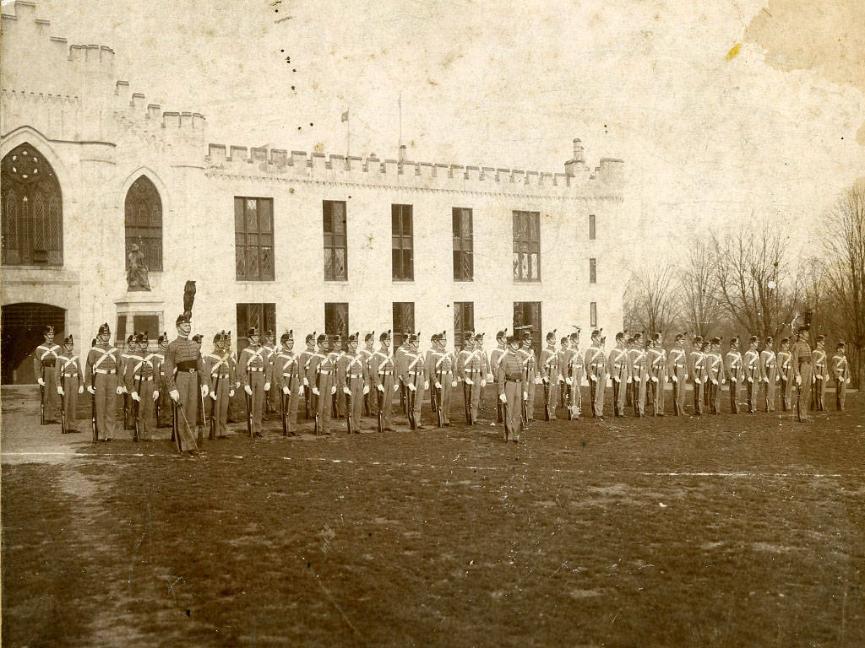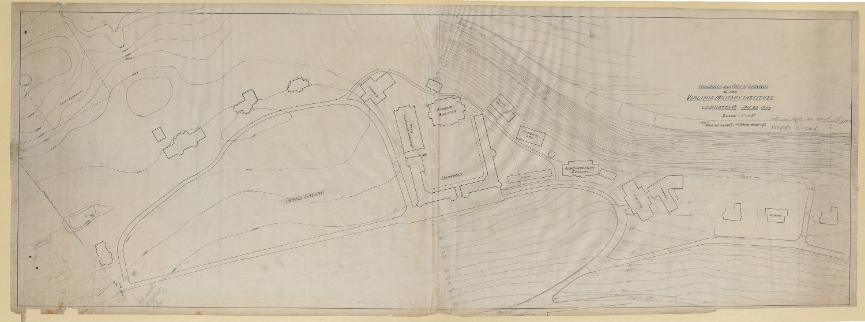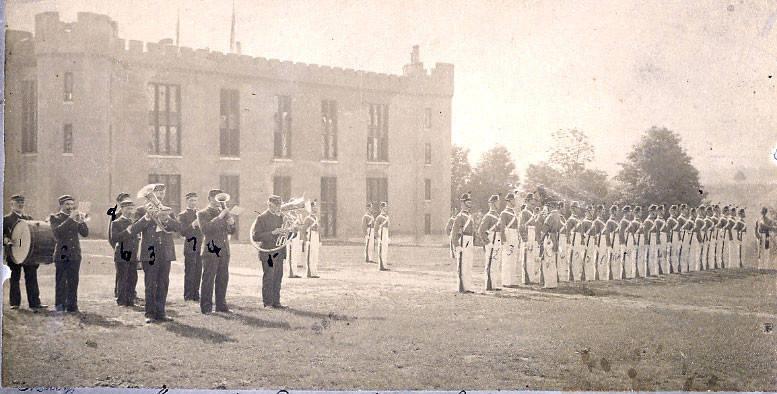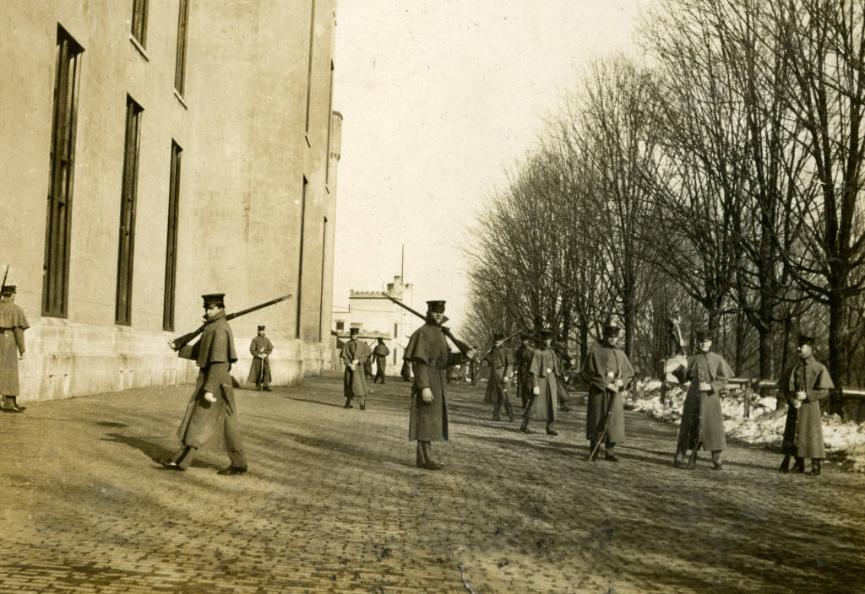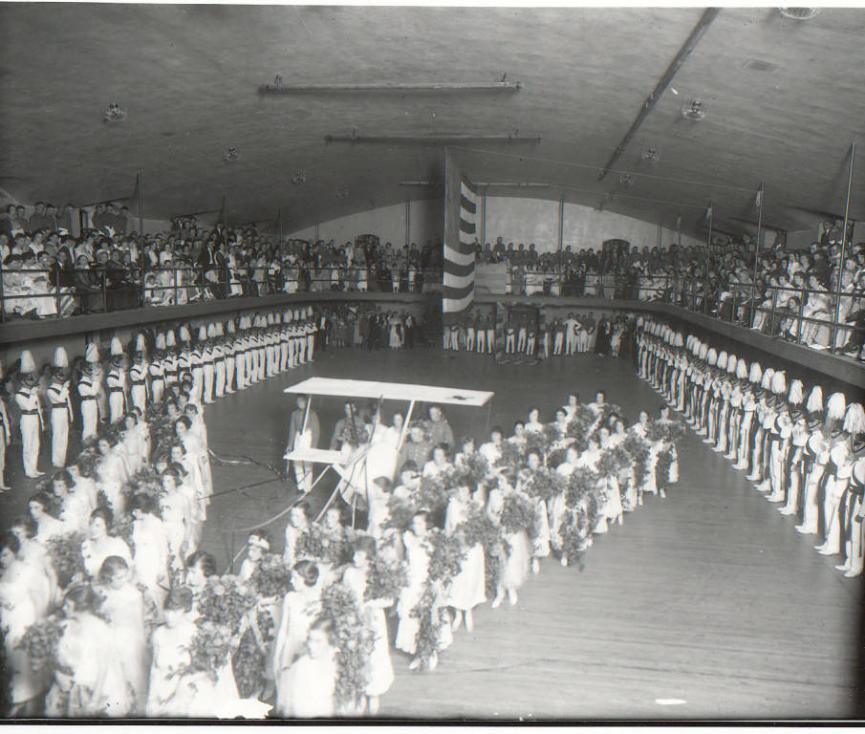Turn of the Century
ERH-411, Spring 2022
Research conducted by Kolton Dobson '23 and Keenan Orr '23 under the guidance of Lt. Col. Pennie Ticen and Maj. Jeff Kozak.
The turn of the century at the Virginia Military Institute occurs during the time period between the 19th century and the 20th century. Specifically, this time period at VMI falls after the Civil War (around 1885), but before World War I (around 1915). The turn of the century at VMI was a period of growth and development in which the Institute evolved into an esteemed collegiate environment. Some of the core aspects of what has earned VMI its reputation today have existed since this time period, such as a newly expanded and rigorous curriculum, a restrictive yet disciplined lifestyle, and military excellence. This time period was ripe with cadet social events, strict military discipline, and numerous leadership opportunities, despite a formal ROTC program not having been established yet. The information presented about this time period reveals that life at VMI was a little bit different than it is today. Yet the striking similarities to modern cadet life display a timeless commitment to holding oneself to a higher standard.
Cadet life at the Virginia Military Institute in the turn of the century can be broken down into six distinct categories: the layout of barracks during the time, uniforms worn by the corps of cadets, corps drill and ceremony, the cadet regulations, military training, and cadet social events. Each of these six characteristics has shaped the everyday life of a VMI cadet since its opening, and have been instrumental in producing the esteemed military and business leaders that graduated from VMI since.

The VMI barracks is one of the most recognizable features of life up on the hill, and as such is central to life as a VMI cadet.
Members of a class during the turn of the century would live on the same floor of the barracks as their classmates. This was done in order to promote camaraderie within members of a class and to build lifelong bonds between brother rats (a term used to refer to the same members of a rat mass). As indicated in the photo below, the four floors of the barracks represented the four classes of the Institute. As each class progressed in their time at VMI, they would in turn move down from the fourth floor to the ground floor.
Corps of Cadets in front of west wing of Barracks, ca. 1880-1890, Part of the VMI Archives Photographs Collection.
In the above photo one can see that parts of barracks are constructed of different colored materials. This is where barracks was reconstructed after Hunter’s Raid during the War.
Barracks today comprises three connected sections, At the turn of the century it had only three walls, the front facing Letcher Avenue and General Washington’s statue. In the 1890’s the parade field side of barracks was extended with the addition of the original Jackson Memorial (J.M.) Hall, extending from Jackson Arch down the parade field. J.M. Hall at the time consisted of a gymnasium, chapel, YMCA, and the offices of the Cadet Newspaper and the Bomb yearbook. J.M. Hall would have been a focal point of a cadet’s free time.
The current facade over Jackson Arch was built at this time and remains over the arch, while J.M. Hall was moved to its current location in the 1920’s, and barracks rooms extended in its place.
The uniform of a VMI cadet is meant to represent to the public the order and discipline that a cadet is called to exude in their day-to-day interactions. In order to accommodate the various activities and responsibilities of a cadet during the turn of the century, cadets were offered a wide range of uniforms to serve their needs.
The most common uniform, the gray blouse, was a fitted wool tunic. The blouse closed with five internal buttons and a storm flap. The cuffs and collar were braided with black mohair, and linen cuffs and collars would be fitted inside with pins. The seams along the back of the blouse are covered with the mohair braid as well. The blouse is worn in summer with pressed white pants made of cotton duck, leading to the nickname ducks. In winter it was worn with thick wool pants with a one-inch stripe covering the seam. Neither pair of pants featured belt loops of pockets.
The coatee was the formal uniform of the corps, used for parade, guard mount, off post activities, and hops. It comprises the same pants as the blouse, as do nearly all uniforms, with a coatee with three rows of brass buttons, cuffs, collars, and a tail with non-functional buttons. The hem on the tail is not sewn closed; this is said to be due to the cadets cutting them to use as bandages at the Battle of New Market, though this is merely myth.
Also seen is what appears to be an early version of the mess jacket, a rather off-and-on uniform at the Institute. This garment is most formal and eventually came to only be worn for the second-class ring figure. It is a standard military type white mess jacket, worn with either pants.
Headgear consisted of a blue forage cap, very similar to the style worn in the Civil War, or a cylindrical shako, worn for formal events and topped with either a pom-pom or a feather plume. Over the course of the early 20th century, the forage cap would lose its slouch and become flared at the top, creating the familiar cover of the modern cadet.
For parades, guard mount, guard, and other official duties, cadet privates, corporals, and some sergeants would attach a cartridge box, belt, bayonet, and two cross straps to their uniforms. Other sergeants and officers would place their saber hangers over their shoulders and wind a red sash around their waists with the ends either just below the belt line or at the knees, respectively. This would then be held in place with the cadet’s leather belt. Additionally, the Officer of the Day of the guard team would wind the sash over the sword hanger, obscuring it.
Informal pose, Class of 1892 Group, Part of the VMI Archives Photographs Collection.
Uniforms of 1892: Cadets pose in front of General Washington’s statues on the parapet, displaying every uniform and variation available to the cadets, ranging from capes, blue blouses, and white mess jackets.
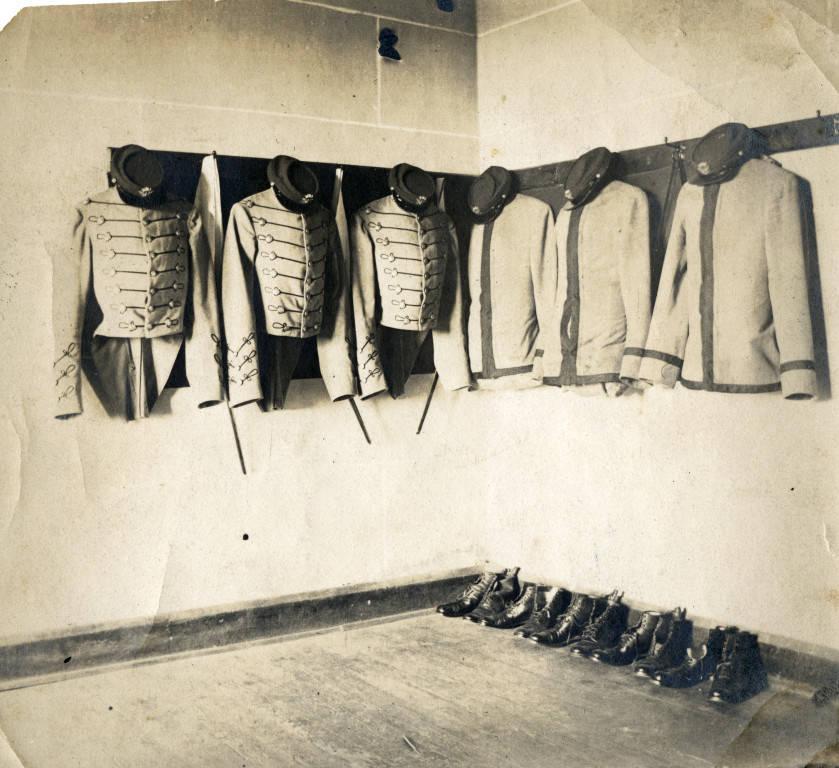
Barracks Room, ca. 1900, Part of the VMI Archives Photographs Collection.
Display of Cadets Uniforms in Barracks Room: Cadets forage caps, coatees, and gray blouses are on display hanging from long hooks on the wall. Today uniforms are stored in large wooden shelving units, and the manner in which cadets have stored their uniforms and accouterments has changed numerous times. Along the wall are black ankle boots, which were worn both in garrison and the field, whereas cadets today wear low quartered shoes and have separate boots for fatigue wear.
Parades in the turn of the century functioned very differently from contemporary parades. A parade is a term used to designate a public display of military excellence and a proficiency in military skills and discipline. While the corps today utilizes similar drill and ceremony, the corps at the turn of the century utilized a more diverse display of marching excellence. Along with a more rigorous training regimen that was displayed, the corps was also smaller and marched on a smaller parade field. The manual of arms for the rifle was different, as was the sequence of parade. The most notable and magnificent formation done by the cadets was the formation of a Pershing Square, in which the whole body of cadets forms one massive square, marching as one whole unit.
Cadet company in formation on Parade Ground, ca. 1907, Parth of the VMI Archives Photographs Collection.
Parade in front of Jackson Arch and Lady Virginia Mourning Her Dead: The coatee is the least changed uniform at VMI. The plumes on the officer’s shakos are taller, the pom-poms of the enlisted cadets considerably smaller than now, and the shakos themselves angled. Otherwise the only notable differences are the angle at which the cross dyke straps are placed across the cadet’s chest, and that the white gloves worn by the cadets are not bloused as they are today. Cadets today are instructed to fold the wrist portion of their gloves forward into the body, exposing skin between the hand and cuff of the uniform. It is unknown when this became a tradition or regulation, though it is believed to have been done of the cadet’s own accord.
Survey Map of Post, 1908, Part of the VMI Archives Collection
This survey of the grounds of the Virginia Military Institute displays the size of the Institute’s parade ground during this time period, as well as the locations and configurations of the several buildings. Compared to the contemporary parade ground, the size of the parade ground was around half of what it is today. To utilize a field of this size, the corps marched in smaller formations which enabled them to maneuver easier without disrupting the flow of spectators viewing the parade. Additionally, cadets paraded considerably more often than today, and would have more opportunities to practice more intricate maneuvers on the parade field.
Guard mount with band, ca. 1894, Part of the VMI Archives Photographs Collection.
Guard Mount with Band 1894: Until after the Second World War music at the institute was provided by musicians hired from Lexington. At this time the guard was mounted on the parade field in Coatee, whereas now it is mounted on the bricks in front of barracks in Gray Blouse. Also of note is the view of the parade field side of barracks prior to the addition of Jackson Memorial Hall, which can be seen in other photographs in the collection.
The Cadet Regulations, or as it is known today, the Blue Book, is a comprehensive list of rules that all members of the VMI Corps are required to adhere to in their service to the Institute. The rules listed in The Cadet Regulations during this time period are far more comprehensive than its modern counterpart. Additionally, the punishments were far stricter for infractions than today.
The regulations of the Virginia Military Institute during the turn of the century, like today, were issued by the commandant of cadets by order of the superintendent. The cadet regulations are meant to ensure that cadets at VMI hold themselves and each other to the highest standards, as well as maintain a military environment within and outside the barracks. Compared to today, the punishment for breaking one of these regulations during the turn of the century period was far stricter. For major offenses such as “running the block”, or leaving post without authorization, the punishment was typically for the cadet to be suspended. The harsh punishments were meant to serve as a deterrent for cadets behaving egregiously out of expectations. For offenses that didn’t warrant cadets leave VMI, cadets were punished at the discretion of the commandant’s staff, commonly resulting in being awarded “penalty tours”. A penalty tour is the name designated for one hour of marching at the front of barracks with one’s rifle. Up to thirty of these tours could be awarded on one special report. For minor infractions, cadets were awarded demerits. A demerit is a blemish on a cadet’s record; after a large accumulation of which will result in penalty tours. The typical allowance of demerits is 20.
It was the duty and responsibility of members of the regimental system to uphold the rules determined by the cadet regulations by placing cadets who broke them on a report notice in the commandant's office. The cadet regulations has listed all of the rules enforced at VMI for generations of classes, and also indicates the direct punishment for each transgression.
Penalty Tours, ca. 1908, part of the Benjamin C. Morgan photograph album, VMI Archives Photographs Collection.
Penalty Tours: Cadets march penalty tours in front of barracks. Penalty tours have been the main method of punishment at VMI since time immemorial, with only minor changes. These cadets appear to be marching alone, whereas now cadets form into platoons when marching.
Military training has always been a staple at the Institute, as cadets have long undergone rigorous tactical military instruction. Much of this style of training has remained in the basic curriculum of a VMI cadet, however as the United States military has diversified, so too has the training conducted at VMI. Military training during the turn of the century was not associated with any one ROTC branch, but rather basic military skills meant to cultivate excellence through leadership roles, and rifle drill and ceremony. The archives are rife with pictures of cadets on Spring March, fording rivers, setting up two-man pup tents, or being served meals in the chow line. Despite the name, the Spring March was not simply a one-day march, it lasted several days with numerous military exercises. These ranged all over Rockbridge County and neighboring counties.
Though the military training offered by VMI was taken from Army manuals, it was not until the Army introduced ROTC that cadets had a direct method of commissioning into the Army. Prior to this, cadets would graduate, take a rather difficult test, and then have to complete what would now be called Officer Candidates School. General of the Army George C. Marshall joined the army in this manner.
The tradition of VMI conducting its own military training lives on through the New Cadet Military Training program in which new fourth classmen are taught the basics of marksmanship and fieldcraft. This training is completed over several weekends over the latter half of the spring semester.
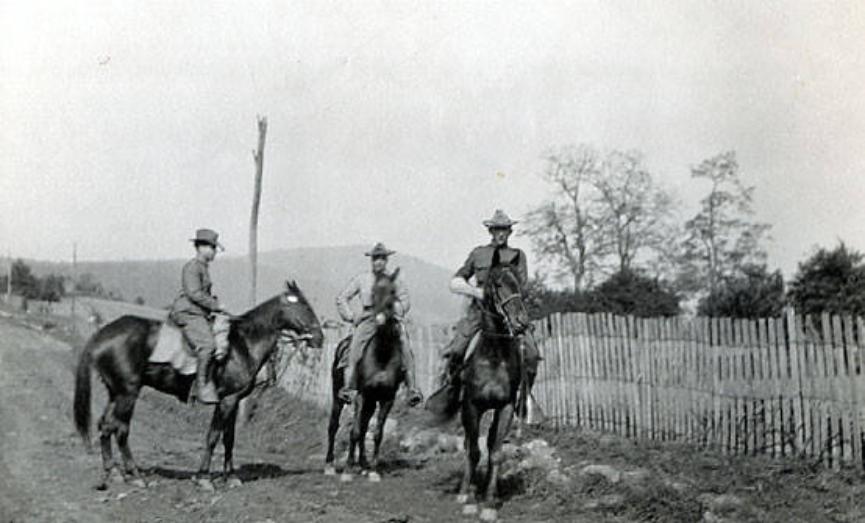
Cadets on horseback during Spring March, May 1910, Part of the VMI Archives Photographs Collection.
Spring March: The Spring March is analogous to the current Spring Field Training Exercise. Prior to the introduction of ROTC, the military aspect of VMI was conducted solely by the Institute, though still according to the infantry regulations of the time.
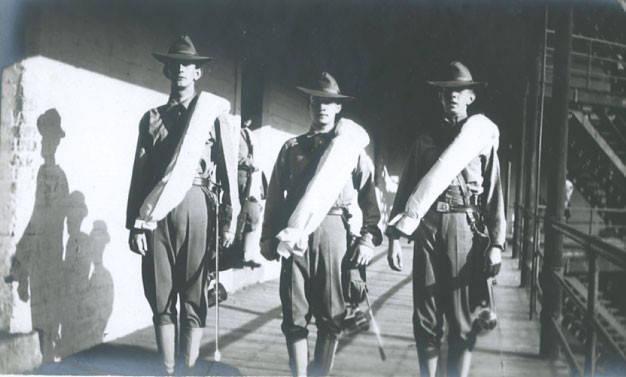
Three cadets in field uniform ready to depart on Spring March, May 1910, Part of the VMI Archives Photographs Collection.
Field Uniform: Whereas now cadets wear the Army Combat Uniform for fatigue duties, at the turn of the century cadets wore a uniform only slightly different than the current Winter Class Dyke. The uniform comprised wool flannel pants without belt loops, black ankle boots with canvas leggings, a wool flannel shirt with tie, a campaign hat, and belt. For the field the cadets have slung blanket rolls, knapsacks, and sabers, indicating that they are cadet officers.
Social events have long been a core aspect of life at VMI as a brief respite from the rigors of cadet life. During the turn of the century, cadets were expected to remain on post far longer than today, having no furloughs for holidays and a much-abbreviated summer. As such the corps was offered many opportunities to experience much needed time away from their busy schedules through social events intended to build pride for VMI among the corps, and strengthen the bonds between brother rats. Some of these planned events were VMI athletic games, a hallmark of which were VMI football games, and cadet dances. These events provided cadets with a much-needed change of pace as well as the opportunity to develop their competitive spirit and self-expression.
A frequent and popular cadet activity at the time were events known as “hops”. These events were traditionally formal dances where cadets were encouraged to bring a date, and enjoy a night of dancing, music, and freedoms not usually offered to cadets at the time, such as extended times off post to pick up and drop off their dates. Today cadets are allowed to spend the night off post with their dates, rather than going back to barracks at the end of the dance. Though cadets are not as restricted now as they once were, they still look forward to a hop.
World War I era dance in the gymnasium, ca. 1918, Part of the VMI Photographs Collection.
1918 Hop: This hop is being held in the gymnasium under Jackson Memorial Hall, when it was still attached to Old Barracks, to the left of Jackson Arch. The dates are forming a V for victory in the First World War, with airplane decorations. The cadets lining the side of the gymnasium are wearing a totally white version of Coatee Full dyke with Arms uniform, something that has not been seen in other photos of the era.
Snake Dance line up, 1915, Part of the VMI Photographs Collection.
Football games were a time for cadets to relax and enjoy a winning season. The cadets above have formed a snake dance after winning a game. Football games offered the cadets a relaxed atmosphere, and though they are mandatory attendance, they are looked forward to as an opportunity to have food and drinks with friends. The games also offer an opportunity to meet dates and the like. Cadets stood during the games, rather than sitting in the bleachers. Today only the rats are required to stand.
Full-size images with zoom capabilities can be viewed by either clicking on the image within the expanding panels or on the link in its citation.
.svg)
.png)
